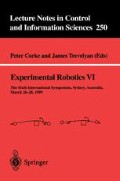Abstract
The use of variable configuration vehicles creates the possibility of direct control of the contact forces between the foot or wheel of a vehicle and the ground. That control is an important element of the coordination of practical walking machines. Control of the contact forces at each wheel is also attractive for wheeled vehicles. For example, the power consumed in driving such a vehicle is quite sensitive to wheel-ground conditions. In conditions of strict power budgets, as in planetary roving vehicles, it becomes attractive to attempt to minimize power consumption by optimizing the wheel-ground contact forces. Unfortunately, control of contact forces in a wheeled vehicle is very complex because of the non-holonomic nature of the system.
In this paper we will review the allocation of contact forces in legged systems and examine the attempts that have been made to apply similar principles to the guidance and propulsion of wheeled systems on uneven terrain. The Adaptive Suspension Vehicle (ASV) and Wheeled Actively Articulated Vehicle (WAAV) from the authors’ laboratory will be used as examples, and as sources of experimental validation of theoretical and numerical results. The former is a six-legged walking machine with each leg having three actively controlled degrees of freedom relative to the vehicle body. The latter is a six-wheeled variable configuration vehicle with three-axis, actively controlled, spherical articulations between successive axles.
Preview
Unable to display preview. Download preview PDF.
References
R. D. Pugh, E. A. Ribble, V. J. Vohnout, T. E. Bihari, M. R. Patterson, and K. J. Waldron. Technical description of the adapative suspension vehicle. Int. J. of Robot. Res., 9(2):24–42, 1990.
J. E. Bares, M. Hebert, T. Kanade, et al. Ambler: An autonomous rover for planetary exploration. IEEE Computer, pages 18–26, June 1989.
C. A. Klein and S. Kittivatcharapong. Optimal force distribution for the legs of a walking machine with friction cone constraints. IEEE Trans. on Robot. and Autom., 6(1):73–85, 1990.
V. Kumar and K. J. Waldron. Force distribution in closed kinematic chains. IEEE J. of Robot. and Autom., 4(6):657–664, December 1988.
S. V. Sreenivasan, P. K. Dutta, and K. J. Waldron. The wheeled actively articulated vehicle (waav): an advanced off-road mobility concept. In Proc. of 4 th Int. Workshop on Advances in Robot Kinematics, Ljubljana, Slovenia, 1994.
J. C. Yu and K. J. Waldron. Design of wheeled actively articulated vehicle. In Proc. of the Second National Applied Mechanisms Robot. Conf., Cincinnati, OH, 1991.
S. V. Sreenivasan. Actively Coordinated Wheeled Vehicle Systems. Phd dissertation, The Ohio State University, 1994.
S. C. Venkataraman. Active Coordination of Wheeled Vehicle Systems for Improved Dynamic Performance. Phd dissertation, The Ohio State University, 1997.
R. B. McGhee and G. I. Iswandhi. Adaptive locomotion of a multi-legged robot over rough terrain. IEEE Trans. on Sys., Man, and Cybernet., 9(4):176–182, 1979.
J. E. Chottiner. Simulation of a six wheeled martian rover called the rocker bogie. Master’s thesis, The Ohio State University, 1992.
G. Klein, K. J. Waldron, and B. Cooper. Current status of mission/system desing for a mars rover. Unmanned Systems, 5(1):28–39, Summer 1986.
M. G. Bekker. Introduction to Terrain Vehicle Systems. The University of Michigan Press, Ann Arbor, 1968.
L. S. McTamaney et al. Final report for mars rover/sample return (mrsr)-studies of rover mobility and surface rendezvous. Technical report, Federal Mining Corp., Santa Clara, CA, December 1989.
A. J. Spiessbach et al. Final report for mars rover/sample return (mrsr)-rover mobility and surface rendezvous studies. Technical Report 958073, Martin Marietta Corp., Denver, CO, October 1988.
C. J. Hubert. Coordination of variably configured vehicles. Master’s thesis, The Ohio State University, 1998.
S. V. Sreenivasan and P. Nanua. Kinematic geometry of wheeled vehicle systems. In Proc. of the ASME Design Technical Conference, 1996.
K. J. Melzer and G. D. Swanson. Performance evaluation of a second generation elastic loop mobility system. Technical Report M-74-7, U.S. Army Engineer Waterways Experiment Station, Mobility and Environmental Laboratory, Vicksburg, June 1974.
Author information
Authors and Affiliations
Corresponding authors
Rights and permissions
Copyright information
© 2000 Springer-Verlag London Limited
About this paper
Cite this paper
Waldron, K.J., Hubert, C.J. (2000). Control of contact forces in wheeled and legged off-road vehicles. In: Experimental Robotics VI. Lecture Notes in Control and Information Sciences, vol 250. Springer, London. https://doi.org/10.1007/BFb0119399
Download citation
DOI: https://doi.org/10.1007/BFb0119399
Published:
Publisher Name: Springer, London
Print ISBN: 978-1-85233-210-5
Online ISBN: 978-1-84628-541-7
eBook Packages: Springer Book Archive

